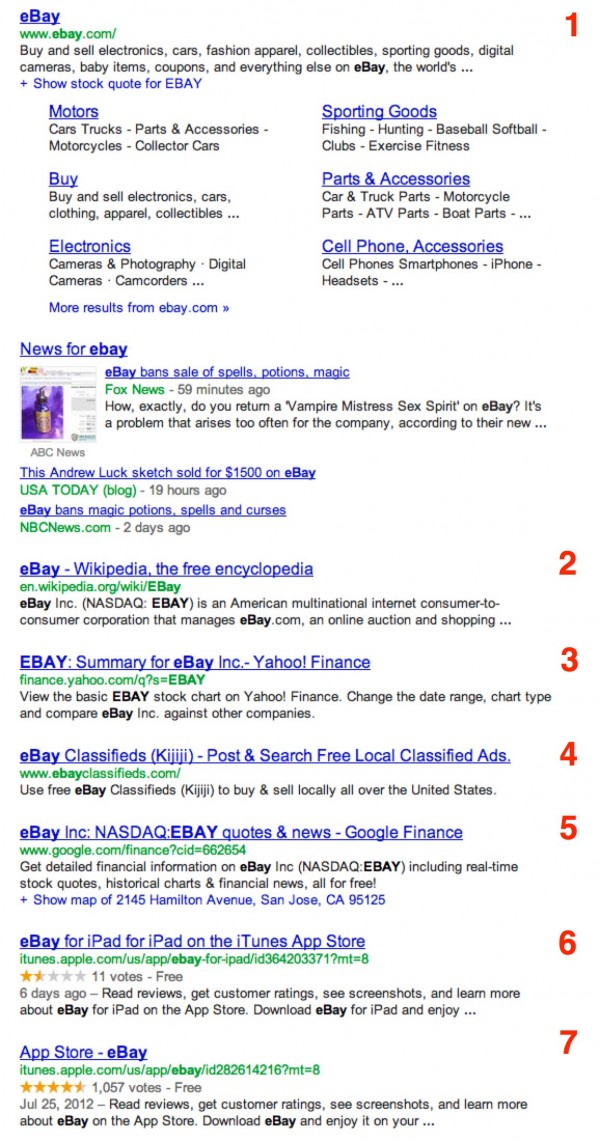7 Is The New 10? Google Showing Fewer Results & More From Same Domain
It looks as if Google is testing a move away from showing the traditional 10 listings to only displaying seven, and it also appears that it’s even easier than ever for one site to dominates all those results. 7 Blue Links We started getting reports last week about the 7-results change last week. Here’s an […]
It looks as if Google is testing a move away from showing the traditional 10 listings to only displaying seven, and it also appears that it’s even easier than ever for one site to dominates all those results.
7 Blue Links
We started getting reports last week about the 7-results change last week. Here’s an example of it for a search on our own name, Search Engine Land:
Here’s another example, for eBay:
When I looked at the eBay search on August 16, when we got our first report of the change happening, it was showing only 6 results. Now, there are 7, not counting the news listing. I don’t count that, because it’s not regular web search result but rather a news box inserted by Google Universal Search.
Spike In The Seven SERPs
Today at SEOmoz, Dr. Peter Meyers crunched some rankings using SEOmoz’s new Mozcast Google “turbulance”prediction tool. He doesn’t say how many rankings he looked at, but it was likely several hundred if not several thousands.
Postscript: In a comment below, Meyers said, “My analysis came from the Mozcast data set, which is a hand-selected set of 1,000 queries and Top 10 SERPs (~10,000 URLs), measured every 24 hours.”
In his post (be sure to check it out), Meyers spotted that about 20% of the search engine results pages (SERPs) at Google now show only 7 listings:
The Sitelinks Connection
Why only 20% and not all the results? It seems that Google is tying the new display format to whether “sitelinks” appear with listings. Wrote Meyers:
You’ll notice two things right away: (1) “PC Tools” is a brand, and (2) the #1 result has expanded site-links. Not every SERP affected appears to be branded, though – a search for “krill” (the #1 result is a Wikipedia entry for the crustacean) also returns 7 results, for example.
It’s similar to what member Buddhu at WebmasterWorld noted in a forum discussion on the topic last week (again, on August 16):
Not sure how much the brand/generic ambiguity plays a part is at all, but certainly every example I’ve seen is an exact domain match that brings up sitelinks.
In other words, if your search term is a domain match and the domain’s result displays sitelinks, then only 7 results are shown.
I see the same, but this appears to be tied to sitelinks, not to brands. Consider this:
For those not familiar, the screenshot shows what sitelinks are, listings that lead further within a particular site beyond the main listing shown for that site.
Sitelinks often show up for brand names, but not always, as in the case above for a search on “england.” That’s why I say that this isn’t a change tied to brands but instead one tied to whether sitelinks appear.
Single Sites Gobble Up The Results
Separately — but still somewhat related — there seems a rise in Google showing many listings on the first page of results all from the same web site.
When I updated my 25 Things I Hate About Google post last year, I noted things had gotten even worse about Google continually showing pages from the same site you’d already seen, from when I first complained about it in 2006. Now, it’s even worse again. Consider this:
It’s not unusual at all to have reports like the one above come in. It’s been happening for several weeks, with reports stronger since Google’s Penguin Update. However, the seeming increase in one site being able to dominate the results might predate Penguin, simply instead being noticed more by those taking a closer look at results after that change.
Site Domination Since 2010, Now Made Stronger?
Indeed, back in the middle of 2010, Google made it official that in some cases, sites might be able to dominate all the results then expanded this later that year.
Now, it feels like another expansion is happening. As said, that’s not directly connected with the shift from 10 to seven results. But it does mean that potentially that brand sites will have an even easier time than ever before to “push down” negative content.
Google recently covered that it’s been working on changes to both sitelinks and site clustering (its term for how it groups pages from the same site). Both shifts covered may be connected to this. But we’re checking with Google to learn more.
Postscript – Google sent this statement:
We’re continuing to work out the best ways to show multiple results from a single site when it’s clear users are interested in that site. Separately, we’re also experimenting with varying the number of results per page, as we do periodically. Overall our goal is to provide the most relevant results for a given query as quickly as possible, whether it’s a wide variety of sources or navigation deep into a particular source. There’s always room for improvement, so we’re going to keep working on getting the mix right.
Related Articles
Contributing authors are invited to create content for Search Engine Land and are chosen for their expertise and contribution to the search community. Our contributors work under the oversight of the editorial staff and contributions are checked for quality and relevance to our readers. Search Engine Land is owned by Semrush. Contributor was not asked to make any direct or indirect mentions of Semrush. The opinions they express are their own.







